Foot massage is an ancient therapy offering deep relaxation, stress relief, and improved circulation. It’s a simple yet powerful practice that promotes overall well-being and can be learned by anyone.
Benefits of Foot Massage
Foot massage offers numerous benefits, including stress relief, improved circulation, and pain reduction. It promotes relaxation, easing tension in the feet and body. Regular sessions can enhance blood flow, benefiting overall health. Foot massage also alleviates discomfort from conditions like plantar fasciitis and arthritis. Additionally, it boosts mood by releasing endorphins, providing a sense of well-being. Many find it helps with sleep quality and reduces muscle stiffness. Whether for self-care or therapy, foot massage is a holistic practice with widespread benefits for both physical and mental health. Its simplicity makes it accessible, offering a natural way to rejuvenate and nurture the body.
Basic Concepts of Foot Massage
Foot massage involves techniques that target specific areas to promote relaxation and relief. It begins with communication, ensuring the recipient is comfortable and their preferences are considered. Using massage oils or lotions is essential for smooth strokes and preventing friction. Basic techniques include gliding, kneading, and applying pressure to key points like the arches and soles. Tools such as rollers or massage balls can enhance the experience. The environment should be calm, with soothing music or dim lighting to create a relaxing atmosphere. Understanding the foot’s anatomy and reflexology zones can deepen the massage’s effectiveness. Proper hygiene and gentle pressure are fundamental to a safe and enjoyable session.
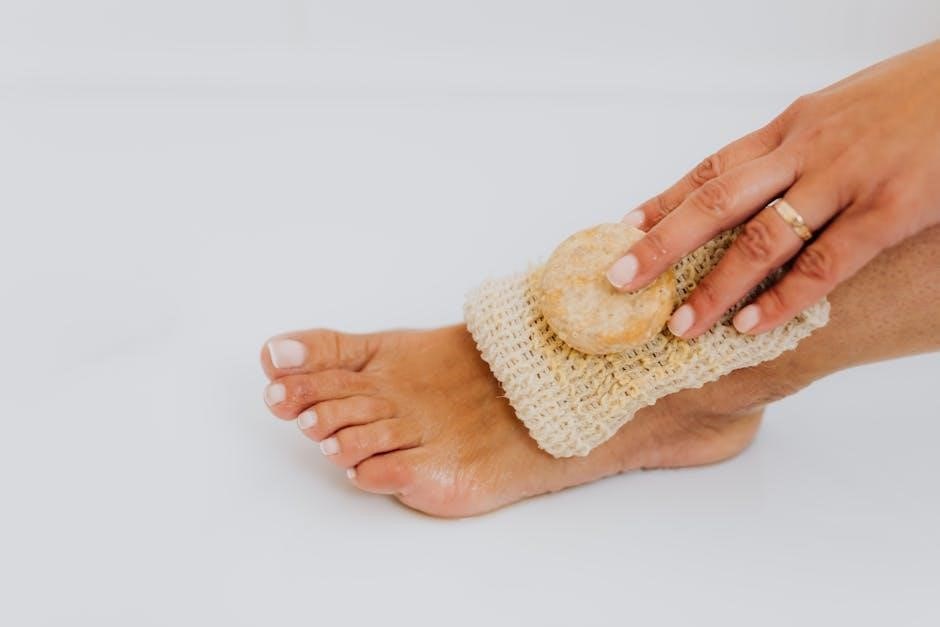
Preparation for a Foot Massage
Preparation involves setting a calm environment, using massage oils, and ensuring cleanliness. Keep sessions under 10 minutes to avoid fatigue and maintain comfort.
Setting the Mood
Creating a serene atmosphere is essential for a relaxing foot massage. Start by choosing a quiet, comfortable space with soft lighting to promote calmness. Ensure the room is warm, as cold environments can tense the muscles. Dim the lights and play soothing music in the background to enhance relaxation. Use scented candles or essential oils, such as lavender or peppermint, to create a calming ambiance. Communicate with the person to understand their preferences, such as pressure intensity or specific areas to focus on. Prepare massage tools and oils in advance to ensure smooth, uninterrupted strokes. Keeping the session brief, around 10 minutes, helps avoid fatigue and maintains comfort. Cleanliness is also key, so ensure the feet and environment are hygienic before starting.
Choosing the Right Massage Oils
Selecting the right massage oil is crucial for a smooth and enjoyable foot massage experience. Coconut oil is ideal for dry feet, providing deep hydration. Almond oil is lightweight and absorbs quickly, making it suitable for most skin types. Peppermint oil offers a cooling effect, reducing fatigue, while lavender oil promotes relaxation and improves sleep. Avoid using heavy or comedogenic oils, especially for acne-prone skin. Always consider the person’s skin type and preferences when choosing. If unsure, opt for neutral oils like jojoba or sweet almond oil. Using high-quality oils ensures better glide and comfort during the massage, enhancing the overall therapeutic benefits.
Selecting Massage Tools and Accessories
Selecting the right tools and accessories can elevate your foot massage experience. Wooden foot rollers are excellent for rolling out the soles and arches, while spiky massage balls provide targeted pressure for knots. Ergonomic foot cradles can help maintain proper foot positioning during the massage. Massage gloves with nodules or texture are useful for applying pressure and ensuring a firm grip. For added comfort, consider using heated boots or warm compresses to relax the muscles before the massage. These tools enhance the effectiveness of the massage and make the process more enjoyable. Choosing high-quality accessories ensures durability and optimal results, making your foot massage sessions more therapeutic and relaxing.
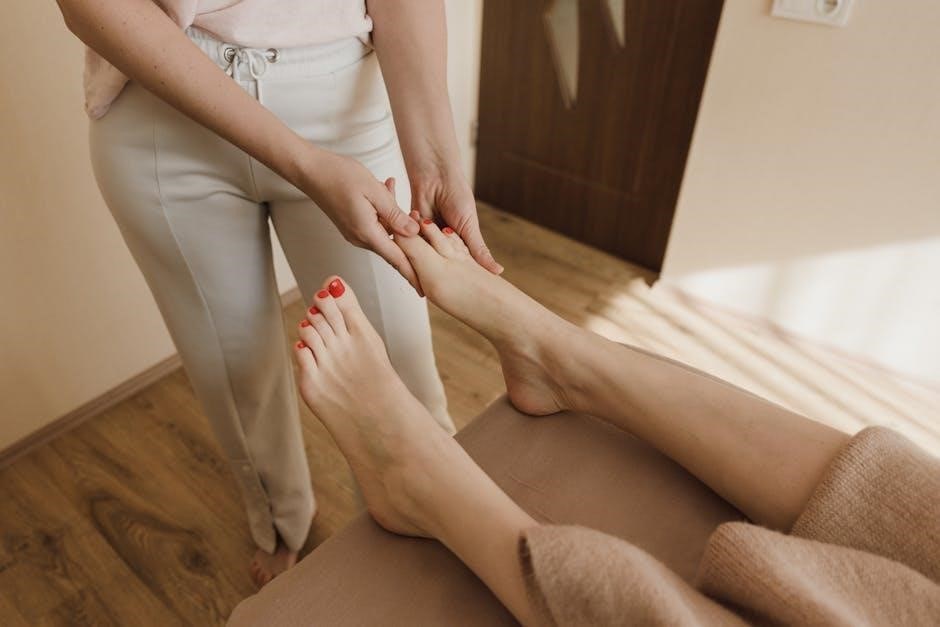
Understanding Foot Anatomy
The foot consists of bones, muscles, and ligaments, with key areas like the arch, heel, and toes. Understanding its structure aids in targeting specific zones effectively during massage.
Key Areas of the Foot
When performing a foot massage, focus on key areas such as the soles, arches, and toes. The soles contain numerous nerve endings and pressure points linked to overall well-being. The arches support the foot and can hold tension, making them a crucial area for relieving stress. The toes, especially the pads, are sensitive and connected to reflexology zones. Additionally, the heel and ball of the foot are areas prone to strain and benefit from targeted massage techniques. Paying attention to these regions ensures a comprehensive and effective foot massage experience, addressing both physical discomfort and promoting relaxation.
Reflexology Zones and Their Significance
Reflexology is a holistic practice that maps specific areas of the feet to organs and systems in the body. These zones, when stimulated, promote health and balance. The toes correspond to the head, sinuses, and brain, while the arch connects to the liver, pancreas, and kidneys. The ball of the foot links to the heart and chest, and the heel to the lower back and intestines. The sides of the foot align with the arms and legs. By targeting these reflexology zones, a foot massage can improve circulation, reduce pain, and enhance overall well-being. Regular practice may also support emotional and physical health by stimulating the body’s natural healing processes.
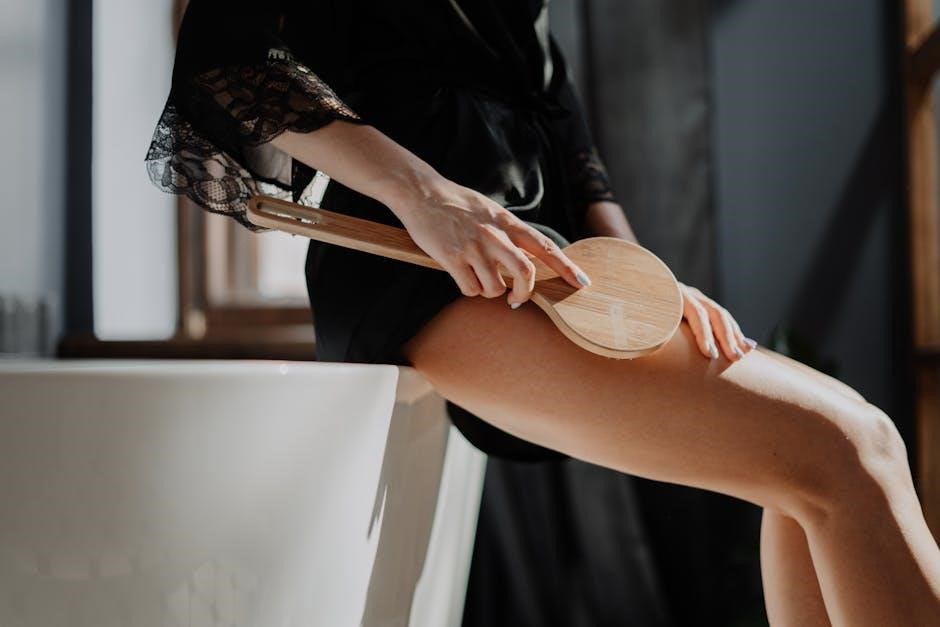
Basic Foot Massage Techniques
Basic techniques include gentle strokes, kneading, and pressure points. Start with oil application, then use fingers and palms to massage from ankle to toes, ensuring relaxation and circulation improvement. Toe bends and knuckle work are essential for relieving tension and enhancing comfort. These methods promote well-being and can be adapted to individual preferences for a soothing experience.
Starting the Massage
Begin by creating a comfortable environment, ensuring the person is relaxed. Gently place their feet in your lap or on a soft surface. Apply a thin layer of massage oil or lotion to the feet, ankles, and lower legs. Start with light, soothing strokes using your palms, gliding from the ankles to the toes. This helps warm up the muscles and improves circulation. Introduce gentle pressure, focusing on the soles and arches, where tension often accumulates. Use your fingers to apply soft, circular motions, gradually increasing pressure if comfortable. Encourage deep breathing to enhance relaxation. Maintain open communication to ensure the pressure and techniques are enjoyable, adjusting as needed for a personalized experience.
Applying Pressure and Strokes
When applying pressure, start gently and gradually increase as needed, paying attention to the individual’s comfort level. Use your thumbs or fingers to apply firm, targeted pressure to areas like the arches and heels. Longitudinal strokes, from the toes to the ankle, help release tension, while transverse strokes across the foot can target specific muscle fibers. Incorporate techniques like knuckle work or toe bends for deeper relaxation. Always communicate to ensure the pressure is comfortable. Focus on sore areas, spending extra time to ease discomfort. Varying your strokes and pressure creates a balanced massage, promoting circulation and relieving muscle tightness; Adjust your technique based on feedback for the best results.
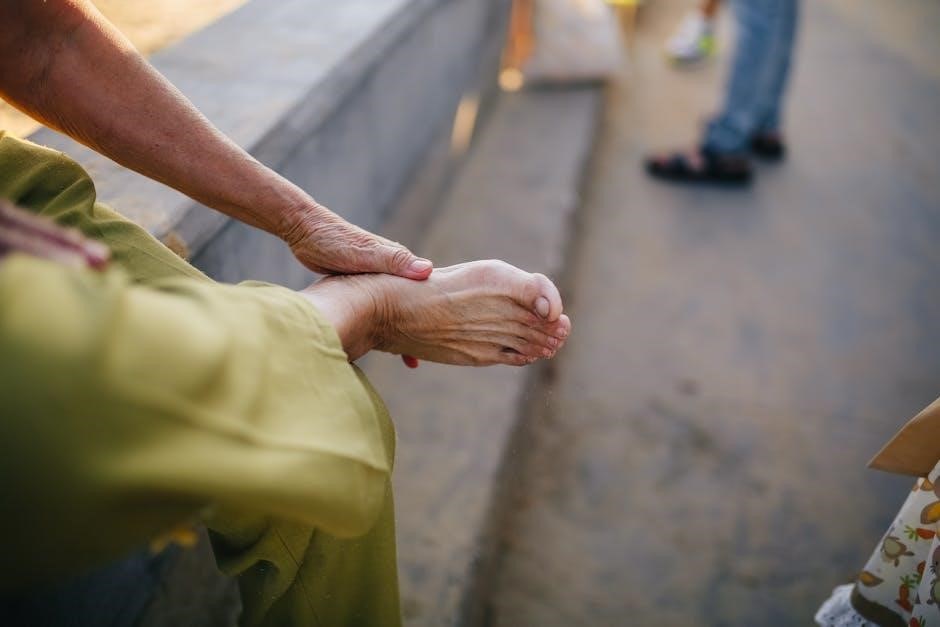
Advanced Foot Massage Methods
Advanced techniques involve incorporating reflexology, using specialized tools like rollers or spiky balls, and applying varied pressures for deeper relaxation and targeted muscle relief.
Incorporating Reflexology Techniques
Reflexology is a holistic practice that involves applying gentle pressure to specific points on the feet, corresponding to organs and systems in the body. By targeting these zones, you can promote relaxation, improve energy flow, and support overall well-being. To incorporate reflexology into your foot massage, start by identifying key areas such as the solar plexus point (located under the ball of the foot) and the spine zone (along the arch). Use your thumbs to apply firm, circular motions. Gentle pressure can help reduce tension and enhance the body’s natural healing processes. This technique complements traditional massage and offers a deeper, more therapeutic experience tailored to individual needs.
Using Massage Tools for Enhanced Results
Massage tools can elevate your foot massage experience, providing deeper relaxation and targeted relief. Wooden foot rollers are ideal for rolling the soles, while spiky massage balls can gently stimulate the arches. Ergonomic foot cradles offer support and help apply precise pressure. Using tools allows you to reach areas that may be difficult to access with hands alone. For added comfort, pair tools with high-quality massage oils or lotions to ensure smooth, gliding motions. Experiment with different tools to find what works best for you or your partner, enhancing the therapeutic benefits of the massage and creating a more professional spa-like experience at home.
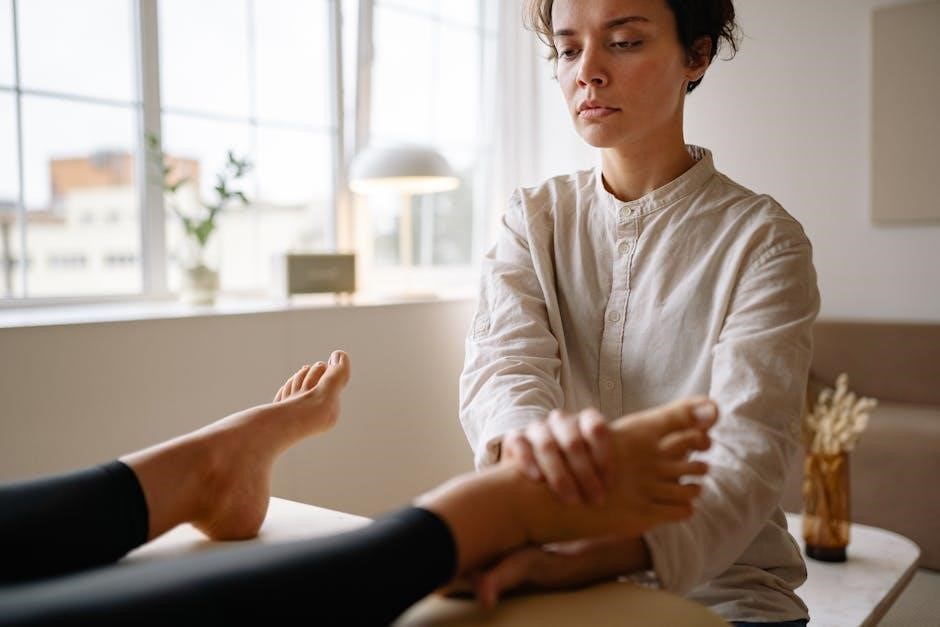
Health Benefits of Foot Massage
Foot massage reduces stress, improves circulation, and alleviates pain. It promotes relaxation, enhances overall well-being, and can even boost energy levels, making it a holistic therapy for mind and body.
Stress Relief and Relaxation
Foot massage is a powerful tool for reducing stress and promoting deep relaxation. By targeting specific areas of the feet, it helps release tension and calm the mind. Gentle pressure and soothing strokes can lower cortisol levels, making it easier to unwind. Incorporating techniques like ankle rotations and toe bends further enhances relaxation. Using oils with calming properties, such as lavender or peppermint, can amplify the experience. Regular foot massages can improve sleep quality and overall mood, making it a holistic approach to managing stress. Whether done professionally or at home, foot massage offers a simple yet effective way to recharge and find tranquility in a busy world.
Improving Circulation
Foot massage plays a significant role in enhancing blood flow and improving circulation. By gently massaging the feet, you can stimulate blood vessels, promoting better oxygen delivery to tissues. Techniques like ankle rotations and toe bends help increase circulation, benefiting overall health. Regular foot massages can also reduce swelling in the feet and ankles, which is particularly beneficial for individuals with sedentary lifestyles. Using massage oils or lotions further enhances the experience by allowing smooth, gliding strokes that boost circulation. Improved blood flow not only rejuvenates the feet but also contributes to overall well-being, making foot massage a valuable practice for maintaining healthy circulation.
Alleviating Pain and Discomfort
Foot massage is an effective way to alleviate pain and discomfort, particularly in the feet and lower extremities. By targeting specific areas such as the soles, arches, and toes, massage helps relieve tension and reduce soreness. Techniques like deep pressure, kneading, and stretching can address common issues like plantar fasciitis or tired, overworked feet. Regular foot massages can also provide long-term relief by improving flexibility and reducing muscle stiffness. Additionally, incorporating tools like spiky massage balls or rollers can enhance the experience, offering targeted relief for areas of discomfort. This practice is especially beneficial for individuals with active lifestyles or those who spend extended periods on their feet.
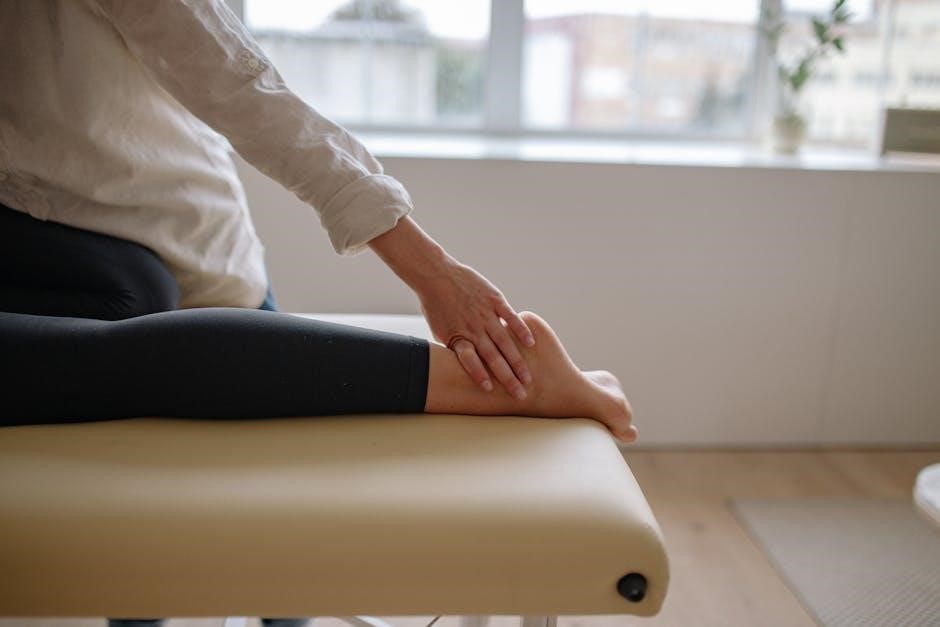
Safety Precautions and Tips
Avoid overusing foot massagers to prevent fatigue. Skip massaging if skin issues like eczema or athlete’s foot are present. Keep sessions under 10 minutes and use high-quality oils.
Duration and Pressure Guidelines
Foot massages should typically last between 10 to 20 minutes for optimal relaxation without causing fatigue. Apply gentle to moderate pressure, adjusting based on the individual’s comfort and feedback. Start with lighter strokes to warm up the muscles, then gradually increase pressure as needed. Focus on sore areas but avoid excessive force, which can cause discomfort. For reflexology points, use firm, targeted pressure for 5-10 seconds; Always listen to the recipient’s feedback and adjust your technique accordingly. Keep sessions concise to ensure effectiveness and avoid overstimulation. This balance ensures a safe and enjoyable experience for both giver and receiver.
Contraindications for Foot Massage
Foot massage may not be suitable for everyone. Certain conditions, such as open wounds, active infections, or severe injuries, require avoidance to prevent further irritation. Individuals with eczema, psoriasis, or athlete’s foot should exercise caution, as massage tools or oils might worsen these conditions. Additionally, people with uncontrolled diabetes, poor circulation, or recent fractures should consult a healthcare professional before receiving a foot massage. Pregnant women, especially in the early stages, should also seek medical advice to ensure safety. Always prioritize the recipient’s health and avoid areas with active pain or inflammation. If unsure, it’s best to avoid the massage or adapt techniques to accommodate specific needs.
Foot massage is a versatile therapy with numerous benefits. Explore additional resources like books and expert tips to enhance your skills. Discover recommended products for a professional experience at home.
Final Tips for a Successful Foot Massage
For a successful foot massage, always communicate with the recipient to ensure comfort and satisfaction. Start with gentle pressure and gradually increase as needed. Use high-quality oils or lotions to facilitate smooth strokes. Incorporate tools like rollers or massage balls for enhanced results. Pay attention to sore areas and spend extra time there. Keep sessions between 10-20 minutes to avoid fatigue. End with light, soothing strokes to promote relaxation. Encourage feedback throughout the session to tailor the massage to their preferences. By combining technique, attention to detail, and a caring approach, you can create a truly rejuvenating experience.
Recommended Products and Tools
For an effective foot massage, consider using high-quality oils like coconut oil for hydration, almond oil for lightweight absorption, or peppermint oil for a cooling effect. Tools such as wooden foot rollers or spiky massage balls can enhance pressure and relieve tension. Ergonomic foot cradles provide optimal leverage for deeper massages. Heated tools or warm compresses can add relaxation. Always choose products suitable for the recipient’s skin type. For a spa-like experience, pair oils with lotions or creams. These tools and products not only elevate the massage quality but also make it more enjoyable and therapeutic, ensuring a professional-grade experience at home.